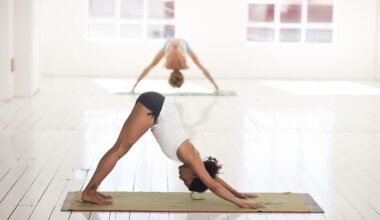Adjusting Recovery Plans Based on Travel Itinerary and Activity Levels
Traveling can greatly disrupt your fitness routine, particularly when it comes to recovery methods that are essential for maintaining peak performance. It is vital to tailor your recovery plans based on your travel itinerary and activity levels. For instance, if you are planning on staying in a city with limited fitness facilities, you’ll need to incorporate strategies that rely on bodyweight exercises and recovery techniques that require minimal equipment. Understanding your agenda and potential obstacles can help you create a flexible yet effective recovery approach. Regular adjustments based on your fitness goals and the constraints of your travel schedule will lead to better results. Therefore, participants should consider scheduling recovery times in coordination with travel movements, workout intensity levels, and personal preferences. Think about prioritizing hydration, nutrition, and rest periods,� to enhance recovery efficiency. Monitoring physical response during each travel phase can provide valuable feedback for subsequent trips, refining not only the recovery routine but also adjusting the workout plans. This process can elevate your fitness journey, making every trip more rewarding and productive while ensuring you remain fit and energized.
Adjusting recovery plans necessitates a keen understanding of how travel impacts the body. Prolonged periods of sitting, changes in sleep patterns, and different time zones can all impair a traveler’s recovery ability. Prior to embarking on your journey, conducting thorough research about available recovery tools at your destination is essential. This could include local spas, gyms, or wellness centers that offer restorative services like massages or cryotherapy. Utilizing technology to locate these options ahead of time allows for optimal planning. Moreover, implementing light stretching or yoga sessions could mitigate stiffness after long flights or drives. These gentle forms of exercise not only facilitate recovery but also enhance flexibility. Another crucial aspect to consider is ensuring restful sleep while traveling. This can often be overlooked yet is integral for muscle recovery. Techniques such as utilizing travel pillows or sleep masks can significantly improve sleep quality. Additionally, incorporating travel-friendly supplements such as protein powders might support your nutritional needs. Hydration must also be a focal point, particularly if you are traveling to places with dry climates. Always carry a refillable water bottle to ensure continuous hydration throughout your journey.
Monitoring Physical Fitness Levels
While traversing different locations, it’s crucial to keep track of your physical fitness levels and adapt your recovery accordingly. One effective method is using fitness trackers or mobile applications that monitor various metrics like heart rate, sleep quality, and physical activities. Having a clear understanding of how your body responds to travel-related stress can inform decisions about when to prioritize rest and recovery. If data indicates that you’re not recovering adequately from workouts, consider adjusting your activity levels on subsequent days. Reducing exercise intensity, duration, or frequency may be warranted to support adequate recovery. Consider allocating a recovery day after intensive travel or significant periods of physical exertion. Engage in low-impact activities such as walking or light cycling for days following strenuous workouts. This active recovery supports blood flow to muscles, which fosters expedited recovery processes. Integrating nutrition also plays a significant role in how well you’re able to recover while traveling. Packing healthy snacks can prevent energy crashes and help maintain optimal performance levels. Fresh fruits, nuts, and protein bars are easily portable and nutritious options. Ultimately, tailoring your recovery journey around your travel dynamics will yield positive fitness outcomes.
Utilizing effective warming-up and cool-down protocols is another pivotal aspect of fitness recovery that travelers must not overlook. Engaging in dynamic stretching before workouts ensures that muscles are prepared for the physical challenges ahead. After each training session during your travels, investing time in static stretching helps to alleviate tension and improve flexibility. Furthermore, consider incorporating foam rolling techniques into your routine. Foam rollers are lightweight and can easily fit into carry-on luggage. Using a foam roller can rectify muscular knots significantly, promoting enhanced blood circulation while stimulating the lymphatic system. As you transition from travel to regular workout periods, be attentive to signs from your body that indicate whether the recovery plan is effective. Tailoring approaches using qualitative feedback from your body is essential. Factors like soreness levels, energy reserves, and motivation can all dictate adjustments to recovery protocols. Listen closely to your body signals. If you feel excessively fatigued, it might be prudent to dial down both the intensity and frequency of workouts until the body rebalances under the stresses of travel. The dynamic nature of travel requires corresponding shifts in your recovery strategies to maintain optimal physical conditions.
Creating Consistency in Recovery
Establishing a consistent recovery routine while traveling can be a challenge; however, the right strategies can help. The foundation of your recovery plan should consist of hydration, proper nutrition, and rest. Always plan meals around whole foods, steering clear of overly processed options that can lead to sluggishness. Prioritizing a diverse meal plan filled with lean proteins, fruits, and vegetables fuels the body and accelerates recovery processes. Whenever possible, opt for accommodations that offer kitchen facilities or meal prep options; preparing your meals allows for greater control over what you consume. Adequate sleep is just as vital; every traveler should aim for at least 7-8 hours of quality sleep each night to restore energy levels. Create an adequate sleep environment by limiting exposure to bright screens and setting a regular bedtime. Implementing relaxation techniques, such as deep breathing or meditation, can facilitate better sleep quality. Make it a point to dedicate time for these nightly rituals during your trips, ensuring that your body is adequately rested for subsequent days’ activities. Following this recovery consistency can keep you feeling fit, motivated, and ready for action throughout your traveling adventures.
The psychological dimension of recovery is equally essential, particularly when navigating the demands of travel. Many travelers experience stress or anxiety that can impede recovery. Integrating mindfulness practices, such as journaling or meditation, allows individuals to reflect on their experiences and maintain focus on their fitness goals. Establishing a positive mindset when facing travel adversities aids in fostering resilience. This mindset facilitates better decision-making concerning rest and recovery. Participating in group fitness activities during travel can also provide social support and keeps motivation levels high. Whether it’s a local running club or a yoga class at your destination, sharing the experience with others enhances enjoyment and accountability. Engaging in group exercise promotes camaraderie and collective motivation, leading to greater commitment to recovery. Additionally, taking the time to explore new locations through active excursions—such as hiking or cycling—can serve dual purposes: fostering physical engagement while integrating local culture. Each travel experience should be embraced as an opportunity to expand your fitness repertoire. By adjusting recovery plans based on travel dynamics and personal needs, you can effectively merge fitness and exploration during your journeys.
Final Thoughts on Travel and Recovery
Combining travel and fitness doesn’t have to be daunting if you approach it with a strategic mindset. Adjusting recovery plans according to your itinerary and activity levels enables you to remain committed to your fitness journey, no matter where you go. Notably, planning proactive recovery processes creates room for flexibility in your fitness routine. Researching local resources ahead of time equips you with essential tools while allowing space to explore new forms of exercise. Adapting to a dynamic environment can inspire you to incorporate novel recovery methods. Consider sharing your insights and experiences with fellow travelers for mutual support. Creating a community around shared fitness aspirations can motivate everyone toward better health and wellness while traveling. Moreover, fostering an adaptive mindset enables you to thrive under changing circumstances. As you embark on your next adventure, remember that successful recovery requires an active and intentional approach. Seek out opportunities to learn and grow through your travel experiences. In conclusion, balancing travel and fitness can enhance your journey, allowing you to appreciate both your physical capabilities and the beauty of the world around you.
And lastly, be sure to document your fitness journey while on the road, capturing both challenges and victories. Taking notes helps track progress and listen to your fitness journey, guiding your future travels. Recording your thoughts can aid your awareness of which recovery methods work best. Understanding your unique needs may lead to adjustments that enhance recovery in subsequent trips and ultimately lead to inspired fitness growth. Remember that travel shouldn’t diminish your health aspirations; instead, it should be a catalyst for growth. Curious to discover more resources? Consider checking out fitness blogs and forums for additional tips tailored to traveling athletes. Experienced travelers might share profound insights on how they seamlessly blend recovery with their travel schedules. Utilizing social media can also foster connections with fellow fitness enthusiasts eager to share their strategies. Engaging with a supportive community bolsters motivation and encourages continued commitment to fitness goals. Collectively, these practices will result in a richer travel experience and foster a healthier, more active lifestyle wherever the journey takes you.


